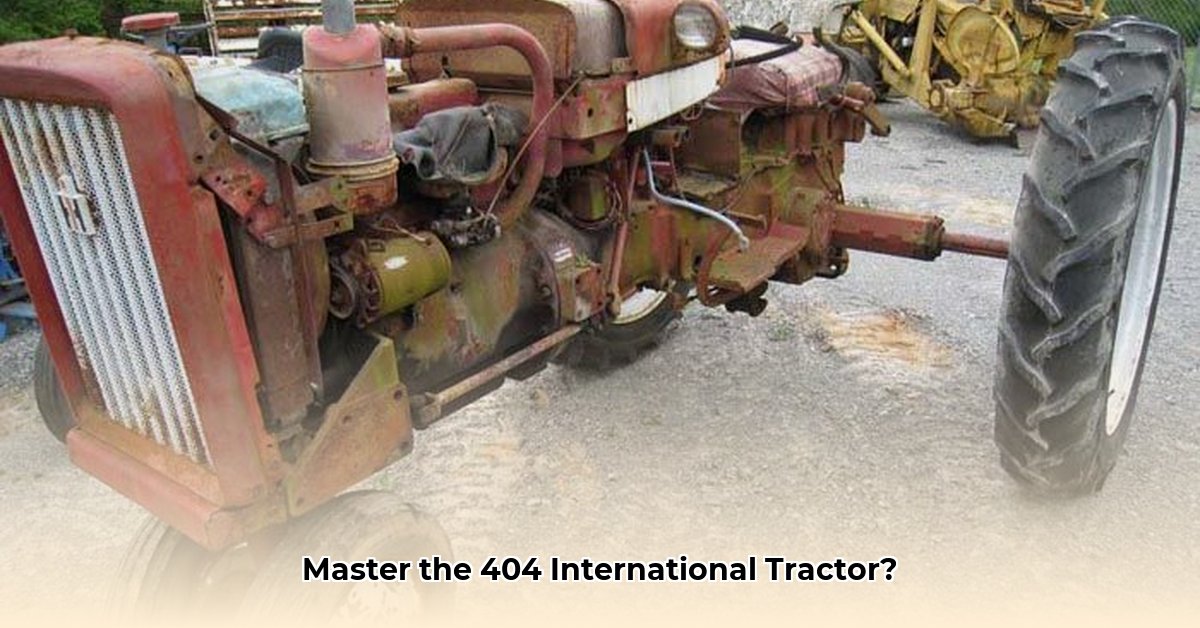
404 International Tractor: A Deep Dive into This Classic Workhorse
The International Harvester 404 tractor, a stalwart of American agriculture, enjoyed a productive lifespan from 1961 to 1968, rolling off the assembly lines in Louisville, Kentucky. More than just a machine, it represents a pivotal era in farming history and remains a desirable find for collectors and enthusiasts. This comprehensive guide delves into the 404's history, technical specifications, operation, maintenance, and restoration, providing both historical context and practical advice for owners and aspiring owners alike. For even more in-depth information, check out this dedicated website: 404 Tractor Info.
Configurations and Capabilities: A Tractor for Every Task
The International Harvester 404 was remarkably versatile—available in three distinct configurations: row-crop, utility, and industrial. This adaptability meant farmers could select the model perfectly suited to their specific needs, much like choosing specialized tools for a particular job. Adding to its flexibility, the 404 offered a choice between gasoline and LP (liquid propane) gas engines, allowing for adaptability based on fuel availability and cost. This inherent adaptability cemented the 404's reputation as a true agricultural workhorse. Did you know that the 404's versatility extended even to its implements? Different attachments could transform it from a plowing powerhouse to an efficient harvesting machine.
Under the Hood: Technical Specifications and What They Mean
Let's explore the technical heart of the 404. The tractor typically boasted a 2.2-liter engine, delivering approximately 33 to 37 PTO (power take-off) horsepower – a significant amount for its time. However, the precise horsepower output varied depending on the fuel type and specific testing methodology. Transmission options, too, varied depending on the year and particular model, underscoring the importance of consulting your tractor's specific documentation. The hydraulic system, while simpler than modern counterparts, proved remarkably capable for its era.
| Feature | Specifications | Additional Notes |
|---|---|---|
| Engine Type | 2.2 Liter, Gasoline or LP-Gas | Power output varied slightly depending on the fuel and testing methods. |
| Transmission | Varied by model and year | Always check your owner's manual for specific transmission details. |
| Hydraulic System | Typically a 5-gallon (18.9-liter) reservoir | Some models offered an optional higher-capacity 9.3 gpm pump. |
| PTO Horsepower | Approximately 33-37 hp | This is an approximate range; actual output could vary slightly. |
| Approximate Weight | Varied significantly based on configuration | Weight varied considerably depending on the specific configuration and added attachments. |
A Practical Guide to Operation: Getting Started and Staying Safe
Operating a 404 safely and effectively requires understanding its unique characteristics. While straightforward, prioritizing safety is paramount.
Step 1: Pre-Operation Checks: Before starting, perform a thorough visual inspection of the tractor. Check fluid levels (oil, coolant, hydraulic fluid), tire pressure, and look for any visible damage or leaks. This preventative step can save you significant headaches down the line.
Step 2: Engage the Clutch: Ensure the clutch pedal is fully depressed before starting the engine. This disengages the engine from the transmission, averting potential damage.
Step 3: Start the Engine: Turn the ignition key to the “on” position. Listen for the engine to crank and start. If it doesn't start immediately, don't repeatedly crank the engine. Give it a moment to rest before attempting again.
Step 4: Engaging Gears: With the engine running smoothly, slowly release the clutch pedal while gently applying the throttle. Familiarize yourself with the clutch's engagement feel to prevent stalling or jerky movements.
Step 5: Using the Hydraulics: If using hydraulics (e.g., lifting implements), operate the levers carefully. Understand the lift system’s response before lifting heavy items, and ensure the implement is securely attached.
Step 6: Safe Operation: Maintain awareness of your surroundings. Exercise caution near slopes, ditches, and other hazards. Never operate the tractor when fatigued.
Maintenance and Repair: Keeping Your 404 in Top Condition
Regular maintenance is crucial for longevity and preventing unexpected breakdowns. This includes regular oil changes, filter replacements (air, fuel, oil), and consistent checks of tire pressure and fluid levels. Inspect belts, hoses, and wiring for wear. While the 404 is mechanically simple, parts might be challenging to source depending on location. Online forums and specialized vintage tractor parts suppliers are invaluable resources. Have you considered preventative measures, such as regular grease applications to key moving parts, to forestall potential problems?
Restoration: Breathing New Life into a Classic
Restoring a 404 is a substantial undertaking—a labor of love demanding patience, mechanical aptitude, and significant time. Parts sourcing can be challenging; creativity and resourcefulness are key. Joining online communities of 404 owners provides essential support, parts leads, and encouragement.
Weighing the Pros and Cons: Is a 404 Right for You?
Pros:
- Simple Mechanical Design: Easier to understand and maintain.
- Robust Construction: Known for durability and longevity.
- Historical Significance: Owning a piece of agricultural history.
- Versatility: Three configurations for varying applications.
Cons:
- Parts Availability: Sourcing parts can be time-consuming and challenging.
- Limited Hydraulic Capacity: Compared to modern tractors, limited lifting capacity.
- Lack of Modern Features: More manual operation compared to modern tractors.
The International Harvester 404 offers a rewarding experience, blending simplicity with robust engineering. Its historical significance and character make it a desirable machine, although potential buyers should weigh the challenges of parts availability and limited capacity carefully. Is the 404 the right classic tractor for you?